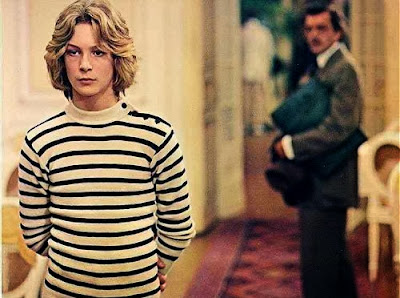Alternative Sibelius from the other Berlin orchestra
That photo above of Potsdamer Platz divided by the Berlin Wall was taken by me on an autumn day in 1975 before I crossed into East Berlin. In the foreground is the evil Wall, in the background is the centre of East Berlin with its TV Tower. The photo at the foot of the post was taken on the same day and shows the memorial to escapers killed trying to cross the River Spree from East to West Berlin.
From 1960 to 1977 Kurt Sanderling (1912-2011) was chief conductor of the Berliner Sinfonie-Orchester (Berlin Symphony Orchestra), which was founded in East Berlin in 1952 to rival the Berlin Philharmonic on the other side of the Wall.
In the 1970s Sanderling and the Berliner Sinfonie-Orchester recorded for the East German label Eterna. This was owned by VEB Deutsche Schallplatten Berlin, the official record company of the German Democratic Republic - VEB stands for Volkseigener Betrieb which translates as state-owned enterprise. Sanderling's Sibelius cycle was reissued by Berlin Classics in 1996, and subsequently in two releases by Dutch budget label Brilliant Classics. The second Brilliant Classics release was in 2020 as a 5 CD set on the label's super-budget Quintessence label.
Despite his links with Shostakovich, Kurt Sanderling is a grossly underrated conductor. His Sibelius is not overtly emotional, and, thankfully, does not fall into the frozen lakes and pine tree trap. It is, as an Amazon reviewer points out, refreshingly free of ego and histrionics. Sanderling's Sibelius is, no more and no less, than Sibelius' Sibelius, and, as I discovered when I visited the composer's house, Finland is not always a picture postcard of frozen lakes and pine trees. Writing in 2010 about my visit I explained:
'Sibelius' house at Järvenpää is a dark and forbidding place on a gloomy December morning. Ten years ago I was in Helsinki on business with a morning to spare and had decided on the spur of the moment to travel out of the city to visit the legendary Villa Ainola, where the photo of Sibelius above was taken in 1944. What I saw on the journey out of the city set the mood. Southern Finland does not have any of the snow-capped peaks mirrored in lakes that grace the covers of Sibelius CDs. It is low-lying glacial country, and December is not always freezing. While I was there in 2000 the few hours of daylight were mild, grey and damp.
After a 45 minute drive through the ribbon developments on the outskirts of Helsinki the coach dropped me on the main road beyond Järvenpää, and I was left standing outside the locked gates of Ainola. I knew that the house would not be open as it was closed to the public during the long Finnish winter. But I had never visited Järvenpää and simply could not miss the chance to stand where those sixteen swans had inspired the finale of the Fifth Symphony.
For several minutes I peered through the fence at
Villa Ainola was where Sibelius lived from 1904 until his death in 1957, and where he had composed his last five symphonies. Then I turned and walked back through the drizzle into the town Järvenpää as heavy lorries thundered past in the gloom. Järvenpää has little to recommend it; I need say no more than that it reminded me of Waterloo, Wisconsin where I spent some time years ago. As I waited for my return coach I drank synthetic coffee dispensed by a vending machine in a strip mall.
My visit to Ainola made a deep and lasting impression. But it was not what I had expected. Yes, I saw Lake Tuusula. But my overriding impressions were of melancholy and claustrophobia. Depression lurked in the gloom, and equilibrium seemed to be slipping away. I had looked into the black abyss evoked by that most enigmatic of twentieth-century symphonies. For many years the composer struggled with depression and found escape in drink.'
On that day in 2000 Järvenpää reminded me of Cold War East Berlin. Like all good interpretations, when appropriate Kurt Sanderling's Sibelius is life-affirming. But it also about the bleakness that, at times, pervaded both Järvenpää and East Germany. Sanderling and the Berliner Sinfonie-Orchester recorded the symphonies in the acoustically blessed Christuskirche in East Berlin. By today's clinical digital standards the sound may be a little dated, but it has stood the test of time well. A reviewer on Amazon writes "I wanted a Sibelius cycle with a full and lush sounding string section. The Berliner-Sinfonie Orchester has just that... You could pay twice the price for a modern lightweight string section and compressed sound. This set is a gem".
The 2020 5 CD Briliant Classics Quintessence release includes Sibelius tone poems performed by Vassily Sinaisky and the Moscow Philhrmonic Orchestra. The set comes with a well-documented booklet that not only includes details of recording venues and dates, but also lists the producer, balance and recording engineers, and tape editors. Brilliant Classics licenses recordings on limited edition deals, and the Quintessence release is becoming difficult to find. However copies are available and the whole set can be bought for less than a single Gustavo Dudamel CD. Alternative Sibelius from the other Berlin orchestra at a bargain price. Why hesitate?










Comments